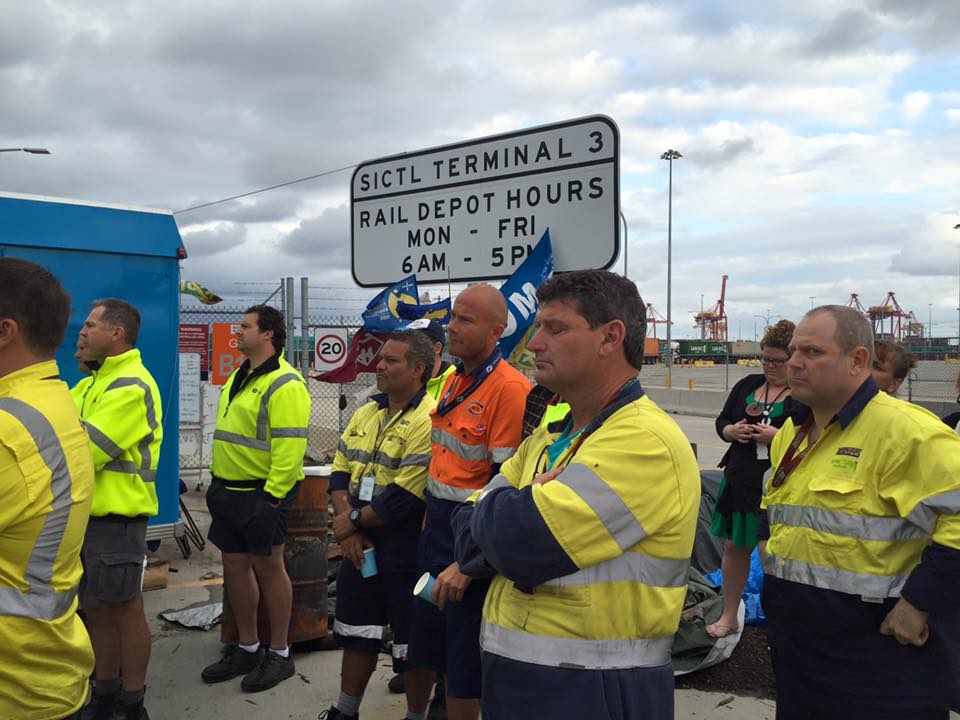Photo: Hutchison Ports – Stop Union Busting
The community assemblies outside the Hutchison terminals in Sydney and Brisbane have gone and the long-standing tents, union banners and flags are now packed away. Many of the Maritime Union of Australia (MUA) members who were sacked back in August have since returned to work.
Beginning in late August, a round of conciliation meetings took place at the Fair Work Commission (FWC) between Hutchison Ports and the MUA. After months of discussions, a negotiated settlement was finally reached last November. This settlement was ratified on November 16 when MUA members at HPA voted by a margin of 147 to 1 to terminate their current (2013) agreement and vote for a new agreement.
Importantly, the negotiated settlement sees no forced redundancies. Given that Hutchison originally sacked 97 of its 224 strong workforce, this is no small achievement. However, part of the settlement was the offer of an “Enhanced Voluntary Redundancy Arrangement” (EVRA) to all 224 workers at HPA. The 64 dockworkers, 36 from Sydney and a further 36 from Brisbane, that accepted this package received a payout of 26 weeks’ pay at their base wage. According to the November 16 Australian Financial Review, this equates to a payment of up to $20,000 over and above their standard redundancy entitlements.
These 64 wharfies will also be placed on a two-year waiting list for the option of returning to Hutchison as casual employees if shipping volumes increase. With industry volumes projected to grow at only 2 to 3 percent a year, shipping at Hutchison will only rise significantly if it wins contracts from the DP World and Patrick/Asciano duopoly. All up, Hutchison Ports has achieved a considerable reduction in the size of its workforce that, while more expensive and smaller than originally planned, is still significant nevertheless.
The new Enterprise Agreement (EA) voted for on November 16 sees a move from the 30-hour roster to a 32-hour week. The amended provisions for a future “Phase 2” of operations will not only see a shift to a 32-hour week roster reducing overtime costs, but will also replace the previous clearly-defined roster with a more flexible indicative-style roster. This will cause actual shift patterns to become more dependent on shipping schedules. While a roster based on a 32-hour week is better than the 35-hour week industry standard, the move away from a 30-hour week and the removal of clearly-defined work rosters are steps in the wrong direction for maritime workers.
The new agreement also provides for casual employment at Hutchison Ports for the first time. The original 2013 agreement provided only for full-time employment based on a 30-hour week with a flexible indicative-style roster. Senior HPA management described the new category of flexible casual employees as providing the company with “greatly enhanced flexibility”.
The 2015 EA also includes new safety clauses, which some MUA representatives have called “the best safety clauses in the industry”. However, a close reading of these clauses suggests that they are little more than the repetition of rights and responsibilities already available to dock workers under current health and safety legislation.
The negotiations have also seen the Maritime Union pull the plug on its Federal Court action that it lodged against Hutchison last August. As reported previously in Left Voice, a judge ruled on August 14 that there was enough “prima facie” evidence to suggest that Hutchison had contravened the Fair Work Act when it sacked 97 dock workers, making the company potentially liable for multi-million dollar fines. On October 8, the two parties reached an in principle agreement that the MUA’s Federal Court proceedings against HPA would be discontinued with “each party bearing their own costs”.
While the company has been handed a “Get out of Jail Free” card, the MUA has not been so lucky. The Fair Work Ombudsman (FWO) has launched an investigation into the “community assembly” protests that stopped all trucks from entering and exiting the terminals during the first week of the dispute. These initial protests were in clear defiance of two Fair Work Commission return to work orders handed out on August 7 and 10. In late September, the MUA began warning its members about FWO attempts to contact union members about these protests. The Fair Work Ombudsman has the power to hit the MUA with multi-million dollar fines, which could then open the way for legal claims for damages against the union.
Both sides have claimed victory in this dispute. According to senior Hutchison management, the negotiated outcome will help the company to “manage its significant costs in a difficult environment” and assist it “in its struggle to achieve market share against well-established competitors in a market plagued with overcapacity and slow growth”. MUA representatives described the settlement as a “major victory for the MUA and all Hutchison workers” and a “wonderful result” which has delivered “justice”.
To move from a position where 97 workers were sacked in August to a negotiated settlement that has not one single forced redundancy is a significant turnaround. But to speak of a “major victory” is another matter. Hutchison Ports now has a significantly reduced workforce, has won a move from a 30-hour to a 32-hour week with more flexible rosters, and now has casual employment for the first time. A continuing Fair Work investigation with its threat of multi-million dollar fines hangs over the head of the MUA. To suggest that the Maritime Union has not sustained losses in this battle is to deny reality. For the MUA, this is not a “major victory” but a defensive, orderly retreat that has avoided a serious defeat.
The 2013 Hutchison Ports Enterprise Agreement can be found here
The new 2015 Hutchison Ports Enterprise Agreement can be found here










